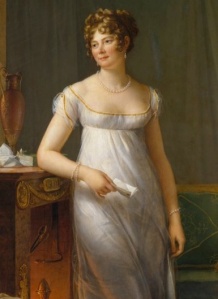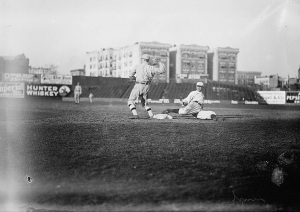 If you visit the lovely Morris-Jumel Mansion in Washington Heights and see a mysterious red-haired beauty, don’t be alarmed.
If you visit the lovely Morris-Jumel Mansion in Washington Heights and see a mysterious red-haired beauty, don’t be alarmed.
It’s just late-18th century New Yorker Eliza Jumel, a notorious social climber who spent much of her adult life in the home, shunned by society and eventually a recluse.
Born in Rhode Island in either 1773 or 1775 to a prostitute mother, Eliza spent her childhood in a workhouse before making her way to New York City in the 1790s to become an actress . . . and marry a rich, socially prominent man.
Young and beautiful, she began an affair with Stephen Jumel, an older French-born wine dealer.
 “Eliza became Jumel’s mistress and for four years he gave her all the material possessions she could desire, but even those could not give her the respectability of ‘proper’ society that she so desperately sought,” wrote Michael Norman and Beth Scott in Historic Haunted America.
“Eliza became Jumel’s mistress and for four years he gave her all the material possessions she could desire, but even those could not give her the respectability of ‘proper’ society that she so desperately sought,” wrote Michael Norman and Beth Scott in Historic Haunted America.
Eliza wanted to be married, so she feigned illness and begged Jumel to marry her. He agreed.
 “According to legend, no sooner had the priest married the couple and left the house than Eliza sat up in bed and began brushing her long red hair,” state Norman and Scott.
“According to legend, no sooner had the priest married the couple and left the house than Eliza sat up in bed and began brushing her long red hair,” state Norman and Scott.
The Jumels moved from Whitehall Street to the Roger Morris House, a summer home miles from the city that served as George Washington’s temporary headquarters during the Revolutionary War.
They redid the place with the latest furnishings from France. But Eliza was shunned by New York’s social scene and went back and forth to France with her husband, finally returning to their home before 1832, the year Jumel died.
It wasn’t long before she found her next wealthy, connected man.
 In 1833 she married former vice president Aaron Burr. It lasted a year, thanks in part to Burr’s womanizing ways and desire for Eliza’s inherited money.
In 1833 she married former vice president Aaron Burr. It lasted a year, thanks in part to Burr’s womanizing ways and desire for Eliza’s inherited money.
For the next three decades, as New York City grew and changed, Eliza remained in her uptown mansion, living and dying alone in her early 90s in 1865.
Though buried five blocks away in Trinity Cemetery on 155th Street, her spirit supposedly haunts her former home, now surrounded by city streets.
“A governess for a child of one of Madame’s nieces said dreadful rappings would occur in the floors and walls of the old woman’s former bedroom,” wrote Norman and Scott.
 “One relative said her ghost, clad in all white, actually stood by her bed.”
“One relative said her ghost, clad in all white, actually stood by her bed.”
And in the 1960s, a group of schoolkids reported seeing “a red-haired woman come out on the balcony and press a finger to her lips.
“She rebuked them for their noisy behavior. Her husband was ill and not to be disturbed, she chided.”
[Top: Eliza as a young beauty; second image: the Morris-Jumel Mansion today, from morrisjumel.org; third image: Aaron Burr; fourth image: Eliza Jumel and younger relatives; fifth photo: Eliza, older]



































